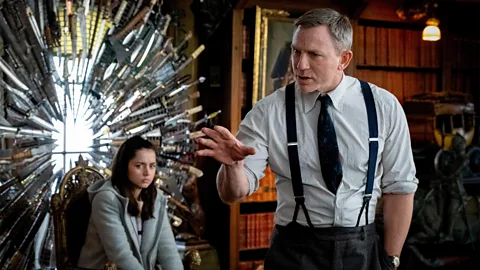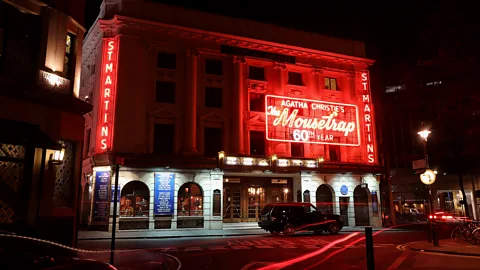The surprising benefits of 'scary play'
 Alamy
AlamyMystery games are hugely popular and have inspired generations of amateur sleuths. But their appeal is more than trivial – they have surprising mental and emotional benefits, and can even help to explain the biases of real eyewitnesses.
In a secret tunnel beneath the streets of 1930s London, screeching mail trains deliver precious parcels to the Royal Household. Suddenly, one of the conductors makes a horrific discovery: the sorting office manager is lying dead on the ground, hit from behind with a crowbar. There are four suspects: Archie, the track engineer. Ruth, the head letter-sorter. Florence, the secretary. And Ernest, the conductor. All of them have a motive – but who is the murderer?
The case of the murdered post manager is one of about 20 scenarios scripted by Sam Emmerson, creative director of Moonstone Murder Mysteries in London, a company that creates and runs immersive mysteries. A cast of actors plays the suspects, and the participants solve the case. Emmerson and his team stage up to a hundred of these interactive shows each year, at private dinner parties, in hotels, and, in the case of the mail-train mystery, titled Murder on the Underground, at the Postal Museum in London.
Emmerson says people like the puzzle aspect of it, and the improvised exchanges with the actors: "It's the reputation that murder mysteries have built up these days, as being a fun thing to go to." But he also acknowledges that it is, in some ways, a surprising phenomenon. After all, real-life violent crime is every person's worst nightmare. "If it was a real-life situation, and someone's been murdered, that's not a fun subject. You're in this sort of [alternate] reality where we're very casually solving the death of a human being."
Murder-inspired board games, card games, interactive books and party games have been around at least since the so-called golden age of British crime fiction in the 1920s and 1930s, which saw the rise of legendary authors such as Agatha Christie, GK Chesterton and Dorothy L Sayers. They popularised the classic tropes of that literary genre, such as a country house or other mysterious and secluded location, a cast of glamorous but suspect characters, and an often amateur sleuth. These hallmarks are still called upon today, as evidenced by the 2019 film Knives Out.
 Rob Jones
Rob JonesThe enduring popularity of these games presents a mystery of its own: what motivates ordinary, law-abiding people to spend an evening investigating fake bloodshed, and hunting pretend murderers?
One simple explanation might be curiosity. But researchers say that is not the full story. Instead, murder games follow a surprisingly intricate set of psychological rules. They allow us to learn and practice important mental and emotional skills, and can even teach us not to overlook important evidence.
The allure of 'scary play'
"The basic idea is that we are using them as a way to simulate threatening scenarios, and then play around with how we would respond to that," Coltan Scrivner, a behavioural scientist and researcher at the University of Chicago, says of games that involve fake danger or violence. The response could be behavioural, or even just emotional, in of handling the fear. He calls such games "scary play", and likens them to play-fighting among animals, which prepares them for real-life fighting, but also hunting or stalking prey.
State of Play
This article is part State of Play, a series from BBC Future on the benefits of embracing playfulness. You might also be interested in some of the other articles:
"In real life, we avoid situations that are anxiety-inducing or fearful for good reason. You don't want to experience something anxiety-inducing in real life, because it has real consequences," he says. "And so we don't get a lot of practice with dealing with those feelings and seeing that we really can come out on the other side of this."
One solution can be to engage with fake threats in a safe setting, and practice emotional coping strategies. Watching horror movies, visiting haunted house attractions, playing murder mystery games, or reading a crime novel, are all forms of such "scary play", says Scrivner.
On the surface, curling up with an Agatha Christie novel may seem to have little in common with screaming one's lungs out in a haunted mansion. But Scrivner says that people simply choose the kind of scary play that is right for them, where the fear feels exciting, but not upsetting. For some, reading a crime story may be enough to create a realistic scenario in their minds, while others may need the stimulation of a physically immersive setting: "There's this sweet spot of fear, where you want to toe the line between reality and fiction, where it seems to be the most fun".
People use various emotional strategies to regulate the fear-factor of an experience and meet that sweet spot, a study by researchers at Aarhus University in Denmark showed. For example, some may seek out interactive experiences and pretend that they are real, to increase the fear.
 Getty Images
Getty ImagesApart from being thrilling, such scary play may help people deal with the real world. In a study by Scrivner and his colleagues, some visitors to a haunted house said it taught them useful things about themselves, such as realising they'd handled the fear better than expected. Another study showed that fans of horror movies had greater psychological resilience during the early months of the Covid-19 pandemic, than people who did not watch such movies.
Similarly, research by psychologists Amanda Vicary at Illinois Wesleyan University and R Chris Fraley at the University of Illinois, shows that women, more so than men, are drawn to books about true crime, and suggests that they may read them partly to learn ways to prevent or survive a crime, and cope with their fear of crime.
Who killed the man in the chair?
The complex psychological factors that draw people to scary play, such as practicing emotional responses and coping with real-life threats, shape the history of classic detective games. One of them is Cluedo (or Clue in the US), arguably the world's most famous murder-mystery board game.
Cluedo was launched in the UK by Waddingtons, a Leeds-based games manufacturer, in 1949, and involves solving a murder in a grand English country house. It was likely inspired by the "lurid fascination with murder and detective games" that arose during the pre-war era, as a by-product of a boom in crime fiction, according to Kitty Ross, a curator of Leeds history and social history at Leeds Museums and Galleries.
That golden age of crime writing gave the world a pattern for murder mysteries to follow. In these stories, death and violence are typically packaged into a tightly constrained setting and plot, meaning that ultimately, the reader can safely expect a clear resolution. Some writers of the era even tried to specify certain rules of the game that a successful plot had to respect, like avoiding accident and coincidence as an explanation. A good mystery involved a logical chain of events that the detective – and reader – could uncover through reason.
The 19th-Century detective, Arthur Conan Doyle's Sherlock Holmes, is a perfect example of that game-like, puzzle-solving approach, as is Christie's sweet-mannered yet coolly analytical Miss Marple. Ross points out that many golden-age stories feature amateur detectives, which may have encouraged readers to test their own skills in games: "They were seizing the idea that they might be able to solve crimes themselves."
Some of these detective games, such as card games with clues, were used as ice-breakers at parties, Ross says. But there were also more complex games and gadgets, such as a 1930s slot machine called "Murder in the Museum: Who killed the man in the chair">window._taboola = window._taboola || []; _taboola.push({ mode: 'alternating-thumbnails-a', container: 'taboola-below-article', placement: 'Below Article', target_type: 'mix' });
